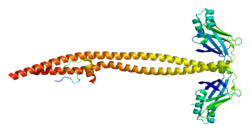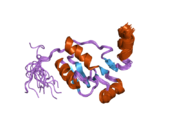LIG4
| edit |
| Ligaza IV, DNK, ATP-zavisna | |||||||||||
|---|---|---|---|---|---|---|---|---|---|---|---|
 PDB prikaz baziran na 1ik9. | |||||||||||
| Dostupne strukture | |||||||||||
| 1IK9, 2E2W, 3II6 | |||||||||||
| Identifikatori | |||||||||||
| Simbol | LIG4 | ||||||||||
| Vanjski ID | OMIM: 601837 MGI: 1335098 HomoloGene: 1736 GeneCards: LIG4 Gene | ||||||||||
| EC broj | 6.5.1.1 | ||||||||||
| |||||||||||
| Pregled RNK izražavanja | |||||||||||
 | |||||||||||
| podaci | |||||||||||
| Ortolozi | |||||||||||
| Vrsta | Čovek | Miš | |||||||||
| Entrez | 3981 | 319583 | |||||||||
| Ensembl | ENSG00000174405 | ENSMUSG00000049717 | |||||||||
| UniProt | P49917 | Q8BTF5 | |||||||||
| RefSeq (mRNA) | NM_001098268.1 | NM_176953.3 | |||||||||
| RefSeq (protein) | NP_001091738.1 | NP_795927.2 | |||||||||
| Lokacija (UCSC) | Chr 13: 108.86 - 108.87 Mb | Chr 8: 9.97 - 9.98 Mb | |||||||||
| PubMed pretraga | [1] | [2] | |||||||||
LIG4 je gen koji kodira proteinsku DNK ligazu IV.[1] Ovaj protein je ATP zavisna DNK ligaza koja spaja dvolančane prekide tokom nehomolognog spajanja krajeva u putu popravke prekida dvostrukog lanca. On je takođe esencijalan za V(D)J rekombinaciju.
Defekti ovog gena uzrokuju LIG4 sindrom. Lig4 homolog u kvascu je Dnl4.
Interakcije
Lig4 formira kompleks sa XRCC4,[2][3] i dalje interaguje sa DNK zavisnom proteinskom kinazom (DNA-PK) i XLF/Cernunnos.
Reference
- ↑ „Entrez Gene: LIG4 ligase IV, DNA, ATP-dependent”.
- ↑ Deshpande Rajashree A, Wilson Thomas E (October 2007). „Modes of interaction among yeast Nej1, Lif1 and Dnl4 proteins and comparison to human XLF, XRCC4 and Lig4”. DNA Repair (Amst.) (Netherlands) 6 (10): 1507–16. DOI:10.1016/j.dnarep.2007.04.014. ISSN 1568-7864. PMC 2064958. PMID 17567543.
- ↑ Sibanda B L, Critchlow S E, Begun J, Pei X Y, Jackson S P, Blundell T L, Pellegrini L (December 2001). „Crystal structure of an Xrcc4-DNA ligase IV complex”. Nat. Struct. Biol. (United States) 8 (12): 1015–9. DOI:10.1038/nsb725. ISSN 1072-8368. PMID 11702069.
Literatura
- Wei YF, Robins P, Carter K, et al. (1995). „Molecular cloning and expression of human cDNAs encoding a novel DNA ligase IV and DNA ligase III, an enzyme active in DNA repair and recombination”. Mol. Cell. Biol. 15 (6): 3206–16. PMC 230553. PMID 7760816.
- Robins P, Lindahl T (1996). „DNA ligase IV from HeLa cell nuclei”. J. Biol. Chem. 271 (39): 24257–61. DOI:10.1074/jbc.271.39.24257. PMID 8798671.
- Grawunder U, Wilm M, Wu X, et al. (1997). „Activity of DNA ligase IV stimulated by complex formation with XRCC4 protein in mammalian cells”. Nature 388 (6641): 492–5. DOI:10.1038/41358. PMID 9242410.
- Critchlow SE, Bowater RP, Jackson SP (1997). „Mammalian DNA double-strand break repair protein XRCC4 interacts with DNA ligase IV”. Curr. Biol. 7 (8): 588–98. DOI:10.1016/S0960-9822(06)00258-2. PMID 9259561.
- Grawunder U, Zimmer D, Leiber MR (1998). „DNA ligase IV binds to XRCC4 via a motif located between rather than within its BRCT domains”. Curr. Biol. 8 (15): 873–6. DOI:10.1016/S0960-9822(07)00349-1. PMID 9705934.
- Grawunder U, Zimmer D, Fugmann S, et al. (1998). „DNA ligase IV is essential for V(D)J recombination and DNA double-strand break repair in human precursor lymphocytes”. Mol. Cell 2 (4): 477–84. DOI:10.1016/S1097-2765(00)80147-1. PMID 9809069.
- Riballo E, Critchlow SE, Teo SH, et al. (1999). „Identification of a defect in DNA ligase IV in a radiosensitive leukaemia patient”. Curr. Biol. 9 (13): 699–702. DOI:10.1016/S0960-9822(99)80311-X. PMID 10395545.
- Kim ST, Lim DS, Canman CE, Kastan MB (2000). „Substrate specificities and identification of putative substrates of ATM kinase family members”. J. Biol. Chem. 274 (53): 37538–43. DOI:10.1074/jbc.274.53.37538. PMID 10608806.
- Nick McElhinny SA, Snowden CM, McCarville J, Ramsden DA (2000). „Ku Recruits the XRCC4-Ligase IV Complex to DNA Ends”. Mol. Cell. Biol. 20 (9): 2996–3003. DOI:10.1128/MCB.20.9.2996-3003.2000. PMC 85565. PMID 10757784.
- Chen L, Trujillo K, Sung P, Tomkinson AE (2000). „Interactions of the DNA ligase IV-XRCC4 complex with DNA ends and the DNA-dependent protein kinase”. J. Biol. Chem. 275 (34): 26196–205. DOI:10.1074/jbc.M000491200. PMID 10854421.
- Lee KJ, Huang J, Takeda Y, Dynan WS (2000). „DNA ligase IV and XRCC4 form a stable mixed tetramer that functions synergistically with other repair factors in a cell-free end-joining system”. J. Biol. Chem. 275 (44): 34787–96. DOI:10.1074/jbc.M004011200. PMID 10945980.
- Riballo E, Doherty AJ, Dai Y, et al. (2001). „Cellular and biochemical impact of a mutation in DNA ligase IV conferring clinical radiosensitivity”. J. Biol. Chem. 276 (33): 31124–32. DOI:10.1074/jbc.M103866200. PMID 11349135.
- Sibanda BL, Critchlow SE, Begun J, et al. (2002). „Crystal structure of an Xrcc4-DNA ligase IV complex”. Nat. Struct. Biol. 8 (12): 1015–9. DOI:10.1038/nsb725. PMID 11702069.
- O'Driscoll M, Cerosaletti KM, Girard PM, et al. (2002). „DNA ligase IV mutations identified in patients exhibiting developmental delay and immunodeficiency”. Mol. Cell 8 (6): 1175–85. DOI:10.1016/S1097-2765(01)00408-7. PMID 11779494.
- Kuschel B, Auranen A, McBride S, et al. (2002). „Variants in DNA double-strand break repair genes and breast cancer susceptibility”. Hum. Mol. Genet. 11 (12): 1399–407. DOI:10.1093/hmg/11.12.1399. PMID 12023982.
- Mahajan KN, Nick McElhinny SA, Mitchell BS, Ramsden DA (2002). „Association of DNA Polymerase μ (pol μ) with Ku and Ligase IV: Role for pol μ in End-Joining Double-Strand Break Repair”. Mol. Cell. Biol. 22 (14): 5194–202. DOI:10.1128/MCB.22.14.5194-5202.2002. PMC 139779. PMID 12077346.
- Roth DB (2002). „Amplifying mechanisms of lymphomagenesis”. Mol. Cell 10 (1): 1–2. DOI:10.1016/S1097-2765(02)00573-7. PMID 12150897.
- Smogorzewska A, Karlseder J, Holtgreve-Grez H, et al. (2003). „DNA ligase IV-dependent NHEJ of deprotected mammalian telomeres in G1 and G2”. Curr. Biol. 12 (19): 1635–44. DOI:10.1016/S0960-9822(02)01179-X. PMID 12361565.
- Roddam PL, Rollinson S, O'Driscoll M, et al. (2003). „Genetic variants of NHEJ DNA ligase IV can affect the risk of developing multiple myeloma, a tumour characterised by aberrant class switch recombination”. J. Med. Genet. 39 (12): 900–5. DOI:10.1136/jmg.39.12.900. PMC 1757220. PMID 12471202.
- Strausberg RL, Feingold EA, Grouse LH, et al. (2003). „Generation and initial analysis of more than 15,000 full-length human and mouse cDNA sequences”. Proc. Natl. Acad. Sci. U.S.A. 99 (26): 16899–903. DOI:10.1073/pnas.242603899. PMC 139241. PMID 12477932.
Vidi još
- p
- r
- u
PDB Galerija
|








